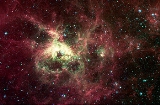
Tarantula Nebula
Overview
H II region
An H II region is a large, low-density cloud of partially ionized gas in which star formation has recently taken place. The short-lived, blue stars forged in these regions emit copious amounts of ultraviolet light, ionizing the surrounding gas...
in the Large Magellanic Cloud
Large Magellanic Cloud
The Large Magellanic Cloud is a nearby irregular galaxy, and is a satellite of the Milky Way. At a distance of slightly less than 50 kiloparsecs , the LMC is the third closest galaxy to the Milky Way, with the Sagittarius Dwarf Spheroidal and Canis Major Dwarf Galaxy lying closer to the center...
(LMC). It was originally thought to be a star
Star
A star is a massive, luminous sphere of plasma held together by gravity. At the end of its lifetime, a star can also contain a proportion of degenerate matter. The nearest star to Earth is the Sun, which is the source of most of the energy on Earth...
, but in 1751 Nicolas Louis de Lacaille
Nicolas Louis de Lacaille
Abbé Nicolas Louis de Lacaille was a French astronomer.He is noted for his catalogue of nearly 10,000 southern stars, including 42 nebulous objects. This catalogue, called Coelum Australe Stelliferum, was published posthumously in 1763. It introduced 14 new constellations which have since become...
recognized its nebula
Nebula
A nebula is an interstellar cloud of dust, hydrogen gas, helium gas and other ionized gases...
r nature.
The Tarantula Nebula has an apparent magnitude
Apparent magnitude
The apparent magnitude of a celestial body is a measure of its brightness as seen by an observer on Earth, adjusted to the value it would have in the absence of the atmosphere...
of 8. Considering its distance of about 49 kpc (160,000 light years), this is an extremely luminous non-stellar object. Its luminosity is so great that if it were as close to Earth
Earth
Earth is the third planet from the Sun, and the densest and fifth-largest of the eight planets in the Solar System. It is also the largest of the Solar System's four terrestrial planets...
as the Orion Nebula
Orion Nebula
The Orion Nebula is a diffuse nebula situated south of Orion's Belt. It is one of the brightest nebulae, and is visible to the naked eye in the night sky. M42 is located at a distance of and is the closest region of massive star formation to Earth. The M42 nebula is estimated to be 24 light...
, the Tarantula Nebula would cast shadows.
Unanswered Questions
Discussions

